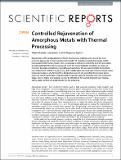Controlled Rejuvenation of Amorphous Metals with Thermal Processing
Author(s)
Wakeda, Masato; Saida, Junji; Li, Ju; Ogata, Shigenobu
DownloadWakeda-2015-Controlled rejuvenation.pdf (737.7Kb)
PUBLISHER_CC
Publisher with Creative Commons License
Creative Commons Attribution
Terms of use
Metadata
Show full item recordAbstract
Rejuvenation is the configurational excitation of amorphous materials and is one of the more promising approaches for improving the deformability of amorphous metals that usually exhibit macroscopic brittle fracture modes. Here, we propose a method to control the level of rejuvenation through systematic thermal processing and clarify the crucial feasibility conditions by means of molecular dynamics simulations of annealing and quenching. We also experimentally demonstrate rejuvenation level control in Zr[subscript 55]Al[subscript 10]Ni[subscript 5]Cu[subscript 30] bulk metallic glass. Our local heat-treatment recipe (rising temperature above 1.1T[subscript g], followed by a temperature quench rate exceeding the previous) opens avenue to modifying the glass properties after it has been cast and processed into near component shape, where a higher local cooling rate may be afforded by for example transient laser heating, adding spatial control and great flexibility to the processing.
Date issued
2015-05Department
Massachusetts Institute of Technology. Department of Nuclear Science and EngineeringJournal
Scientific Reports
Publisher
Nature Publishing Group
Citation
Wakeda, Masato, Junji Saida, Ju Li, and Shigenobu Ogata. “Controlled Rejuvenation of Amorphous Metals with Thermal Processing.” Scientific Reports 5 (May 26, 2015): 10545.
Version: Final published version
ISSN
2045-2322